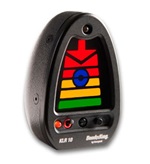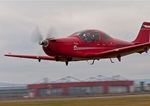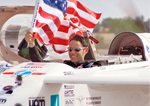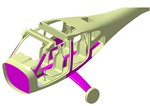General aviation may still rely heavily on technology from—let’s be kind—a few decades ago, but there have been some noteworthy advances in recent years. In 2014, we saw new products introduced, and research move forward on others that hold promise to increase safety, efficiency, and fun in the future.
AOPA covered a range of stories about new gadgets, systems, and aircraft, documenting everything from round-the-clock solar flight to aircraft-mounted laser guns. Here’s a look back at our favorites.
Fuels for the future
A major milestone toward the development of a lead-free alternative to avgas was marked in September, when the FAA announced the selection of four unleaded candidates to undergo testing slated to continue through the fall of 2015. That development was welcome news for owners of tens of thousands of aircraft that require high-octane formulations. There was also some welcome news on the diesel front, with various manufacturers closing in on new certifications.

Stall protection
Pilots are taught that airspeed is no guarantee of lift—a stall can happen at any airspeed, any attitude, and it can be a real problem for pilots caught unaware. For most of the history of powered flight, pilots had to infer their angle of attack based on a combination of speed and attitude, and how the airplane feels. The stall horn has been around for years, but it won’t always warn soon enough of trouble. BendixKing and Safe Flight both rolled out devices in 2014 that change that game, offering a combination of visual and audio indicators. BendixKing’s KLR 10 retails for $1,600 and won approval for installation in standard category aircraft. Safe Flight SCx is designed to both warn the pilot of dangerous conditions, and also find the optimal angle of attack to maximize efficiency in any phase of flight.

Propeller vision
A research team in Germany captured the first digital images of a propeller blade in flight, a feat once believed impossible because of rotational forces that exceed 20 G. Those images proved that even the stiffest airfoils flex and bend under such forces, and will allow engineers to design more efficient propellers, helicopter rotors, and wind turbine blades in years to come.

Laser gun for aircraft
Granted, it is unlikely that the laser turret being developed by Lockheed Martin, the U.S. Air Force, and the University of Notre Dame will ever be an option on a general aviation aircraft, but you have to admit it’s pretty cool that the developers used a Falcon 10 to test a laser turret.
Laser defense for aircraft
Another kind of laser—one developed for boardroom presentations and astronomy—has bedeviled pilots in recent years, with potential for disaster if a beam blinds a flight crew at the wrong moment. A research team in Canada is closing in on a practical solution, a thin film applied to goggles or an entire windshield that blocks the beam but allows other kinds of light to pass through.

In-flight recharging
Battery capacity remains the biggest obstacle standing in the way of electric power for general aviation aircraft. Chip Yates (who has set several world records for electric-powered flight) plans to fly across the Atlantic Ocean on battery power, using current battery technology. How is this possible? Yates is working on adding another first to his list: air-to-air recharging.
Solar power
Aviation was built on pioneers willing to risk it all for greatness, and the Solar Impulse team is cut from the same cloth. Solar Impulse 2 made its maiden flight in June, a two-hour sortie that was the first in a series of test flights that will test and prepare the revolutionary aircraft (powered entirely by the sun) for circumnavigation in 2015.

Racing to a safer cockpit
Flight Design borrows heavily from the automotive world, including a segment of the automotive world that travels at speeds significantly faster than any light sport aircraft in level cruise: Formula One. The same technology that has saved dozens of lives in auto racing since the deadly 1970s is being adapted for Flight Design’s C4, expected to be certified in 2015. The C4 will incorporate many of the same design features and strategies that have protected racing drivers by directing impact energy around and away from the cockpit.
Wing morphing
In an example of aviation technology coming full circle, NASA teamed with the Air Force Research Laboratory and FlexSys of Michigan to test wing-morphing on a Gulfstream business jet. This control approach was used by the Wright Brothers, though the modern version is noticeably more sophisticated—not to mention designed for much faster aircraft. The goal back then was simply controlling an aircraft. Modern wing warping seeks to dramatically increase aerodynamic performance and efficiency.
Flying slower
While aviation has long celebrated speed, engineers are working on new strategies for flying slower. The German Aerospace Center (Deutsches Zentrum für Luft- und Raumfahrt; DLR) are preparing to test new strategies for slow flight in a wind tunnel. First, they had to fly an Airbus A320 into the stall regime (a decidedly atypical mission for a large transport aircraft). The goal here is to make future aircraft that operate more quietly, and from shorter runways.



